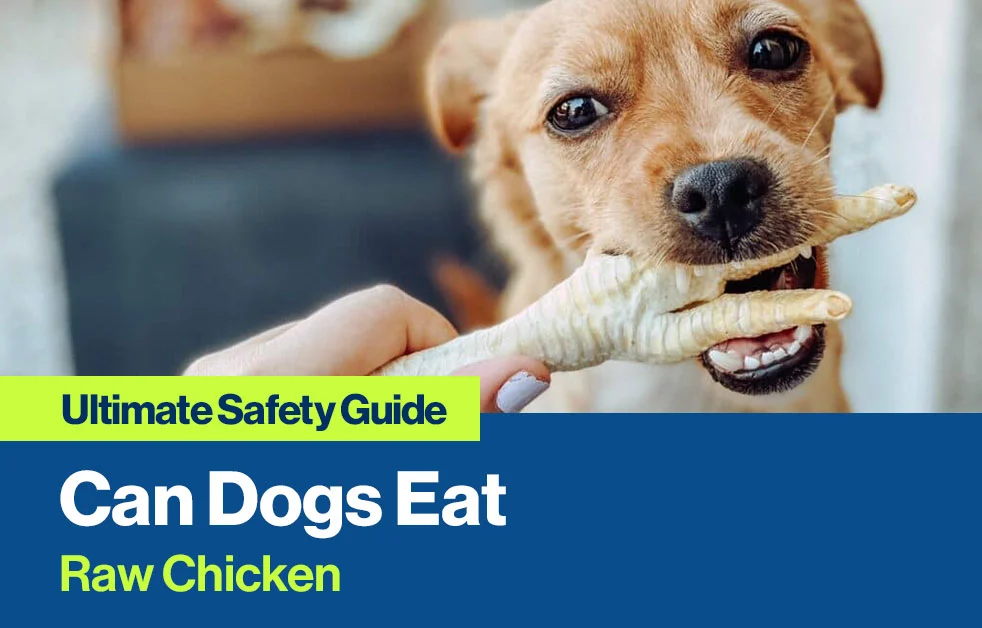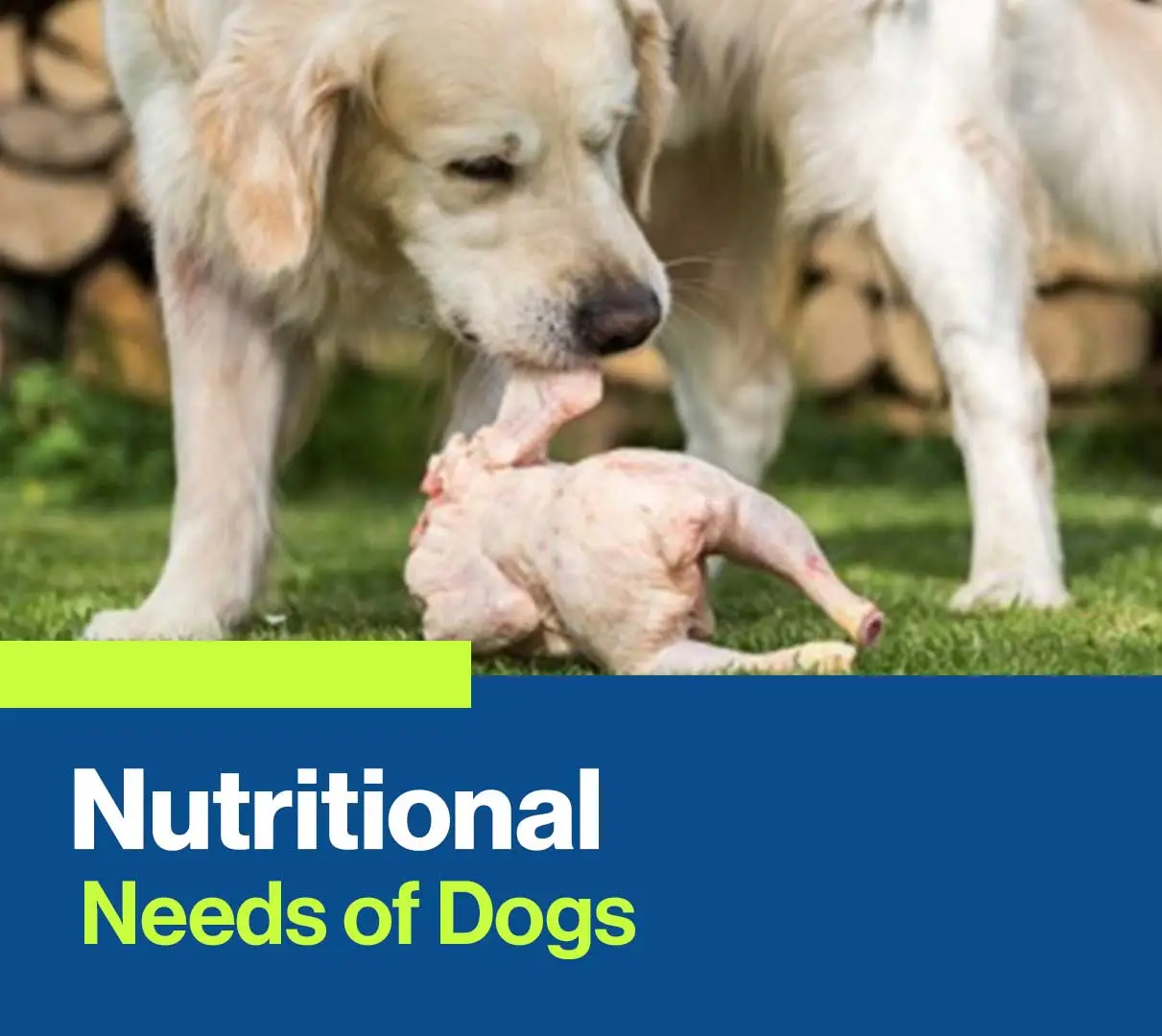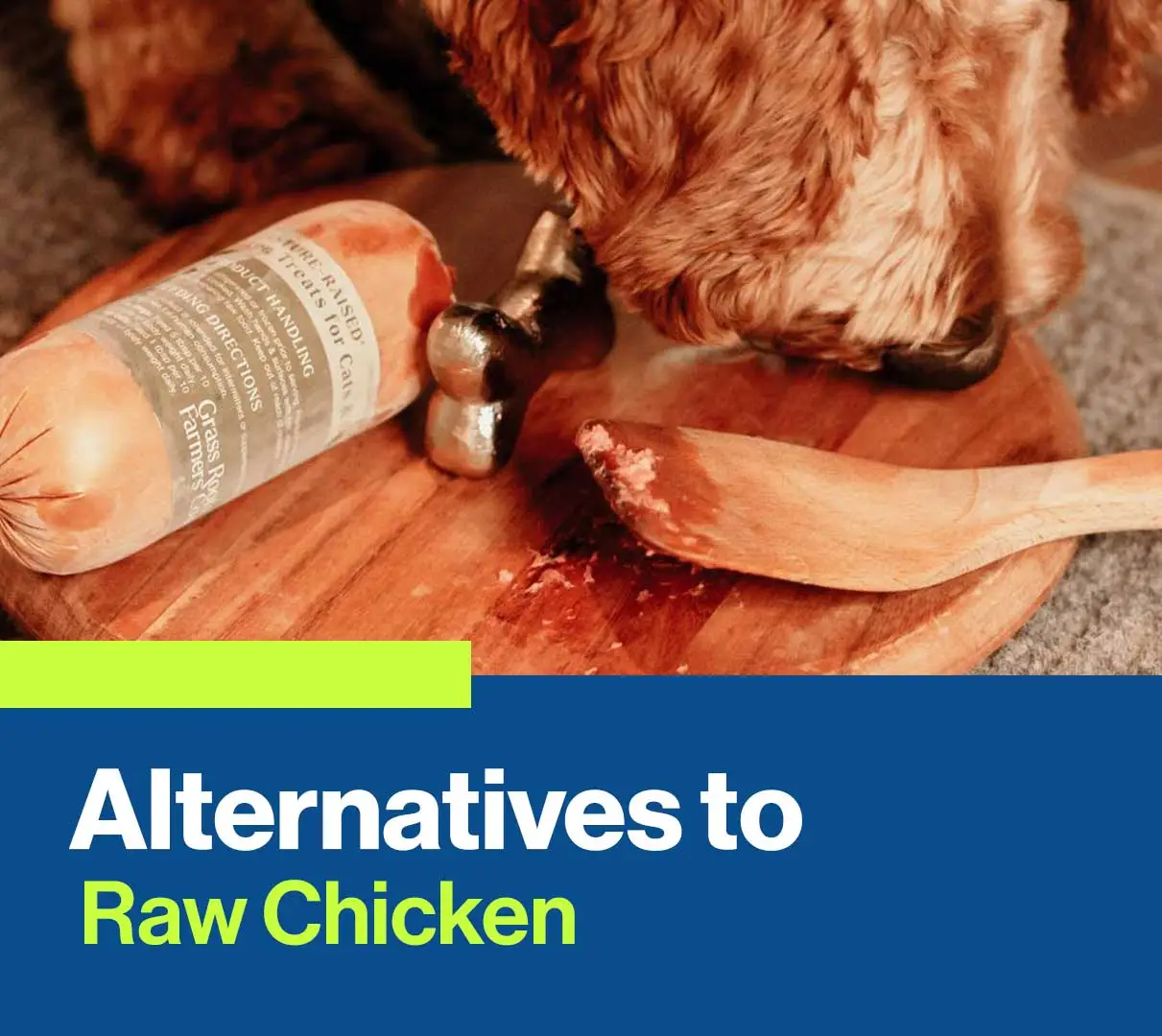Wondering if you can feed your furry friend raw chicken? The answer lies in understanding both the benefits and risks involved. Many dog owners are curious about the raw food diet and often ask, “Can dogs eat raw chicken?”
In this ultimate safety guide, we will explore the nutritional aspects, potential hazards, and expert recommendations to help you make an informed decision for your pet.
Table of Contents
ToggleIntroduction to Raw Diets
Many dog owners wonder, “Can dogs eat raw chicken?” To answer this, we need to understand the concept of raw diets. Raw diets for dogs have become popular in recent years.
These diets include raw meat, bones, fruits, and vegetables. Some believe that raw diets mimic what dogs ate before they became domesticated.
Benefits of Raw Diets
Raw diets offer several benefits for dogs. These diets can improve a dog’s overall health.
- Improved Digestion: Raw diets are easier for dogs to digest. This can lead to better nutrient absorption.
- Healthier Skin and Coat: Many dog owners notice shinier coats and healthier skin. Raw diets can provide essential oils and nutrients.
- Increased Energy Levels: Dogs on raw diets often have more energy. This can make playtime more fun.
A raw diet may also help with weight management. Dogs consuming raw food may feel fuller longer. This can reduce overeating.
| Benefit | Explanation |
|---|---|
| Better Dental Health | Chewing raw bones can clean teeth. |
| Stronger Immune System | Raw diets can boost a dog’s immune system. |
Risks of Raw Diets
While raw diets have benefits, there are also risks. These risks need careful consideration.
- Bacterial Contamination: Raw meat can contain harmful bacteria. This can make dogs and their owners sick.
- Choking Hazards: Raw bones can be a choking risk. They can also cause internal injuries.
- Unbalanced Nutrition: Raw diets can lack essential nutrients. This can lead to deficiencies over time.
Owners should consult a vet before switching to a raw diet. A vet can help create a balanced meal plan. Handling raw meat requires caution. Always wash hands and surfaces after preparing raw dog food.
| Risk | Explanation |
|---|---|
| Parasites | Raw meat can contain parasites. |
| Bone Splinters | Raw bones can splinter and cause damage. |
Nutritional Needs of Dogs
Many dog owners wonder about the safety and benefits of feeding their dogs raw chicken. Understanding the nutritional needs of dogs is essential to make informed decisions about their diet. Dogs require a variety of nutrients to stay healthy and active.
Essential Nutrients
Dogs need a range of essential nutrients to thrive. These nutrients support their overall health, energy levels, and immune system. Here are some key nutrients every dog needs:
- Proteins: Essential for muscle growth and repair. Proteins also support a healthy coat and skin.
- Fats: Provide energy and help absorb vitamins. Fats are also crucial for brain function.
- Vitamins: Vital for metabolic processes. Vitamins A, D, E, and K are particularly important.
- Minerals: Support bone health, nerve function, and fluid balance. Calcium and phosphorus are key minerals.
- Water: Vital for all bodily functions. Ensure your dog always has access to fresh water.
Here is a table summarizing the essential nutrients and their sources:
| Nutrient | Source |
|---|---|
| Proteins | Meat, Fish, Eggs |
| Fats | Fish Oil, Chicken Fat |
| Vitamins | Fruits, Vegetables |
| Minerals | Bone Meal, Vegetables |
| Water | Fresh Water |
Balanced Diet Importance
A balanced diet is crucial for a dog’s health. It ensures they get all the necessary nutrients in the right proportions. Feeding only one type of food, like raw chicken, can lead to nutritional imbalances. Here are some reasons why a balanced diet is important:
- Prevents Deficiencies: A balanced diet prevents deficiencies in essential nutrients, which can lead to health problems.
- Supports Growth: Puppies need a balanced diet for healthy growth and development.
- Maintains Weight: A balanced diet helps maintain a healthy weight, reducing the risk of obesity.
- Boosts Immunity: Proper nutrition supports the immune system, helping dogs fight off illnesses.
- Promotes Longevity: A balanced diet contributes to a longer, healthier life.
Consider the following balanced meal components for your dog:
- Protein Sources: Chicken, Beef, Fish
- Carbohydrates: Rice, Sweet Potatoes
- Vegetables: Carrots, Spinach
- Fruits: Apples, Blueberries
- Healthy Fats: Fish Oil, Flaxseed Oil
Ensuring your dog’s diet is balanced will help them live a happy and healthy life.
Raw Chicken Basics
Dogs are often seen as part of the family, and their diet is essential for their health. Many dog owners wonder, can dogs eat raw chicken? Understanding the basics of raw chicken and how it can be prepared safely is crucial.
This section will cover the types of raw chicken and the best ways to prepare it for your furry friend.
Types of Raw Chicken
There are several types of raw chicken that you can feed your dog. Each type has its own benefits and considerations. Here are the common types:
- Whole Chicken: Includes the meat, bones, and organs. This provides a balanced diet.
- Chicken Thighs: High in fat and protein. They have bones that are safe for dogs.
- Chicken Wings: They are smaller and easier to chew. Great for smaller dogs.
- Chicken Breast: Lean meat with less fat. Ideal for dogs needing fewer calories.
- Chicken Necks: Rich in cartilage and calcium. Good for dental health.
Here’s a quick comparison table for better understanding:
| Type | Protein Content | Fat Content | Bone Content |
|---|---|---|---|
| Whole Chicken | High | Moderate | High |
| Chicken Thighs | High | High | Moderate |
| Chicken Wings | Moderate | Moderate | High |
| Chicken Breast | High | Low | None |
| Chicken Necks | Moderate | Low | High |
Preparing Raw Chicken
Preparing raw chicken properly ensures your dog’s safety. Follow these steps to prepare raw chicken:
- Clean the Area: Ensure all surfaces are clean. Use hot, soapy water to kill bacteria.
- Use Fresh Chicken: Check the expiration date. Fresh chicken reduces the risk of foodborne illness.
- Cut into Pieces: Depending on your dog’s size, cut chicken into appropriate pieces. Use a clean knife.
- Store Properly: If not used immediately, store the chicken in an airtight container. Refrigerate or freeze to keep it fresh.
- Wash Hands: Always wash your hands with soap and water after handling raw chicken. This prevents contamination.
Here’s a checklist to ensure you don’t miss any steps:
- Clean preparation area
- Check freshness of chicken
- Cut chicken into suitable pieces
- Store chicken correctly
- Wash hands thoroughly
By following these steps, you can safely prepare raw chicken for your dog. This ensures they get the nutrition they need without the risk of illness.
Health Benefits of Raw Chicken
Many dog owners are curious about feeding their dogs raw chicken. While this diet can be controversial, there are several health benefits to consider. Raw chicken can provide essential nutrients that promote overall health.
Let’s explore the potential health benefits of feeding your dog raw chicken.
Protein Source
Raw chicken is an excellent source of protein for dogs. Protein is crucial for maintaining muscle mass and overall body functions. Here are some key benefits of protein from raw chicken:
- Muscle Development: Protein helps in building and repairing muscles. This is especially important for active dogs.
- Energy Boost: Protein provides a sustainable energy source, keeping your dog active and healthy.
- Immune System Support: The amino acids in protein help strengthen the immune system, making your dog less prone to illnesses.
Below is a table highlighting the protein content in raw chicken:
| Chicken Part | Protein Content (per 100g) |
|---|---|
| Chicken Breast | 31g |
| Chicken Thigh | 19g |
| Chicken Wing | 24g |
Feeding raw chicken ensures your dog gets high-quality protein, aiding in their overall growth and well-being.
Improved Coat Condition
Another significant benefit of raw chicken is the improvement in your dog’s coat condition. A healthy coat is a sign of a healthy dog. Here’s how raw chicken contributes to this:
- Essential Fatty Acids: Raw chicken contains omega-6 fatty acids, which are vital for a shiny coat.
- Vitamin B: The B vitamins in raw chicken support skin health, reducing dryness and irritation.
- Hydration: Raw chicken has a high moisture content, keeping your dog’s skin hydrated.
A well-balanced diet with raw chicken can lead to:
- Softer and shinier fur
- Reduced shedding
- Fewer skin issues
Including raw chicken in your dog’s diet can significantly improve their coat quality, making them look healthier and more vibrant.
Potential Risks of Raw Chicken
Feeding dogs raw chicken has become a popular trend among pet owners. Many believe it’s more natural and healthier than commercial dog foods. But it’s important to be aware of the potential risks of raw chicken.
Understanding these risks can help you make an informed decision for your furry friend.
Bacterial Contamination
Raw chicken can be contaminated with harmful bacteria. These bacteria can make your dog very sick. Salmonella and Campylobacter are common bacteria found in raw chicken. They can cause serious health issues in dogs.
Here are some signs of bacterial infection in dogs:
- Diarrhea
- Vomiting
- Lethargy
- Loss of appetite
These symptoms can lead to dehydration and other complications. It’s crucial to monitor your dog closely if you feed them raw chicken. Humans can also get sick from handling raw chicken.
Always wash your hands and clean surfaces after handling raw meat. This helps prevent the spread of bacteria in your home.
Here is a table with the common bacteria and their effects:
| Bacteria | Effects on Dogs |
|---|---|
| Salmonella | Diarrhea, fever, abdominal pain |
| Campylobacter | Diarrhea, vomiting, fever |
Bone Hazards
Raw chicken bones can pose serious risks to dogs. Bones can splinter and cause injuries. Choking is a major concern with chicken bones. Splintered bones can also cause:
- Internal injuries
- Blockages in the digestive tract
- Damage to the mouth and throat
If a bone gets stuck, it might need surgical removal. This can be very stressful for your dog and expensive for you. It’s safer to avoid feeding your dog raw chicken bones. Cooked bones can be even more dangerous as they splinter more easily.
Always supervise your dog if they are eating raw meat. Make sure to remove any bones before feeding them chicken. Understanding these hazards can help keep your dog safe and healthy.
Alternatives to Raw Chicken
Feeding dogs raw chicken can be risky. Bacteria like Salmonella can make both dogs and their owners sick. Luckily, there are alternatives to raw chicken that are safer and healthier for your furry friend.
Cooked Chicken Options
Cooked chicken is a safer choice compared to raw chicken. Cooking kills harmful bacteria. There are several ways to prepare chicken for dogs:
- Boiled Chicken: Boiling chicken is easy. Remove the skin and bones first. Boil the chicken until fully cooked. Let it cool before serving.
- Baked Chicken: Baking chicken is another great option. Preheat the oven to 375°F. Place the chicken on a baking sheet. Bake for 20-30 minutes. Ensure the chicken is fully cooked.
- Grilled Chicken: Grilling chicken can add a delicious flavor. Make sure the chicken is fully cooked. Avoid adding any seasonings that could be harmful to dogs.
Here’s a simple table to compare these methods:
| Method | Preparation Time | Cooking Time |
|---|---|---|
| Boiled Chicken | 10 minutes | 15-20 minutes |
| Baked Chicken | 10 minutes | 20-30 minutes |
| Grilled Chicken | 10 minutes | 15-20 minutes |
Cooked chicken can be mixed with dog food or given as a treat. It provides a good source of protein. Always ensure the chicken is plain. Avoid onions, garlic, or other seasonings.
Commercial Raw Diets
For those who prefer raw diets, commercial raw diets offer a safer alternative. These diets are prepared under strict guidelines. They ensure the food is free from harmful bacteria.
Commercial raw diets often include a balanced mix of proteins, vegetables, and grains. Advantages of commercial raw diets include:
- Safety: Companies follow strict hygiene practices. This reduces the risk of contamination.
- Convenience: No need to prepare meals. Simply open the package and serve.
- Nutrition: These diets are balanced. They provide all the necessary nutrients for dogs.
Some popular commercial raw diet brands include:
- Instinct Raw: Offers a variety of proteins. Includes beef, chicken, and lamb.
- Primal Pet Foods: Provides freeze-dried options. Easy to store and serve.
- Stella & Chewy’s: Known for high-quality ingredients. Includes organic vegetables and fruits.
Using commercial raw diets can be a convenient and safe way to feed your dog. Always consult your vet before changing your dog’s diet. Choose reputable brands to ensure quality and safety.
Signs of Allergies or Intolerance
Can dogs eat raw chicken? While some dogs thrive on a raw diet, others may experience allergies or intolerance. It’s crucial to recognize the signs of allergic reactions or digestive issues. This guide will help you identify common symptoms and know when to consult a vet.
Common Symptoms
Dogs may show various symptoms if they are allergic or intolerant to raw chicken. It’s important to watch for these signs:
- Itching and Scratching: Your dog may scratch more than usual, especially around their ears, paws, and belly.
- Skin Issues: Redness, rashes, and hives can appear on your dog’s skin.
- Digestive Problems: Diarrhea, vomiting, or excessive gas may occur after eating raw chicken.
- Ear Infections: Frequent ear infections can be a sign of food allergies.
- Respiratory Issues: Sneezing, coughing, or difficulty breathing can indicate an allergic reaction.
Identifying these symptoms early can help prevent more severe health issues. Keep a close eye on your dog after introducing raw chicken into their diet.
When to Consult A Vet
If you notice any of the above symptoms, it’s essential to seek veterinary advice. Here are some specific scenarios that warrant a vet visit:
- Persistent Symptoms: If itching, scratching, or digestive problems continue for more than a few days.
- Severe Reactions: If your dog experiences difficulty breathing, swelling, or severe vomiting and diarrhea.
- Behavioral Changes: Noticeable changes in behavior, such as lethargy or aggression, can indicate discomfort.
- Recurring Issues: Frequent ear infections or skin problems that do not improve with treatment.
A vet can perform tests to determine if your dog is allergic or intolerant to raw chicken. They may suggest an elimination diet to identify the problematic ingredient.
Always consult a vet before making significant changes to your dog’s diet, especially if they show adverse reactions.
Monitoring your dog’s health and seeking prompt veterinary care ensures they stay happy and healthy. Keep your furry friend safe by being attentive to their needs.
Expert Opinions on Raw Chicken
Raw chicken for dogs is a topic that sparks much debate among pet owners. While some believe it is a natural and healthy option, others worry about potential health risks.
This section will delve into the expert opinions on raw chicken, featuring insights from veterinarians and pet nutritionists.
Veterinary Insights
Veterinarians often caution against feeding dogs raw chicken. They highlight several concerns:
- Bacterial Contamination: Raw chicken can harbor harmful bacteria like Salmonella and Campylobacter. These can cause severe gastrointestinal issues in dogs.
- Parasites: Raw chicken may contain parasites that could infect your dog, leading to health complications.
- Nutritional Imbalance: Feeding only raw chicken can lead to a lack of essential nutrients. Dogs need a balanced diet for optimal health.
In a survey, many veterinarians noted that they see cases of foodborne illnesses in dogs fed raw chicken. The table below summarizes the common issues observed:
| Issue | Percentage of Cases |
|---|---|
| Gastrointestinal Problems | 45% |
| Parasitic Infections | 30% |
| Nutritional Deficiencies | 25% |
Veterinarians recommend thoroughly cooking chicken before serving it to your dog. This practice kills harmful bacteria and parasites, ensuring the meat is safe for consumption.
Pet Nutritionists’ Views
Pet nutritionists have varied opinions on raw chicken. Some support it, while others advise caution. Supporters argue that:
- Natural Diet: Raw chicken is closer to what dogs’ wild ancestors ate. It can provide natural nutrients that cooking might destroy.
- Improved Digestion: Some dogs may digest raw meat better than cooked meat. This can lead to fewer digestive issues.
Those who advise caution point out:
- Balanced Diet: Raw chicken alone is not enough. Dogs need a mix of proteins, fats, vitamins, and minerals.
- Food Safety: Handling raw chicken requires strict hygiene practices to prevent contamination.
Pet nutritionists often recommend consulting with a vet before starting a raw diet. They also advise a gradual transition to monitor your dog’s response. The table below shows a sample transition plan:
| Week | Raw Chicken Portion | Cooked Food Portion |
|---|---|---|
| 1 | 25% | 75% |
| 2 | 50% | 50% |
| 3 | 75% | 25% |
| 4 | 100% | 0% |
This gradual transition helps your dog adapt to the new diet, reducing the risk of digestive issues.
Frequently Asked Questions (FAQ)
Can Dogs Safely Eat Raw Chicken?
Dogs can eat raw chicken, but it’s risky. Raw chicken may contain harmful bacteria like Salmonella. Always consult your vet before introducing raw chicken into your dog’s diet.
What Are The Benefits of Raw Chicken For Dogs?
Raw chicken provides high-quality protein. It also contains essential nutrients like vitamins and minerals. However, the risk of bacterial contamination is significant.
Are There Risks to Feeding Dogs Raw Chicken?
Yes, raw chicken can contain harmful bacteria. It may lead to foodborne illnesses in dogs. Always handle and prepare raw chicken carefully.
How Should Raw Chicken Be Prepared For Dogs?
Always buy fresh, high-quality chicken. Clean and sanitize surfaces and utensils. Consider freezing the chicken first to kill parasites.
Conclusion
In summary, the question Can Dogs Eat Raw Chicken is not just a simple yes or no. It’s essential to consider various factors, including the dog’s health, age, and any pre-existing conditions.
While some pet owners choose to include raw chicken in their dog’s diet, it is crucial to take precautions to minimize the risk of bacterial contamination and nutritional imbalance. Always consult with your veterinarian before making significant changes to your dog’s diet.
By understanding the potential risks and benefits associated with feeding raw chicken, you can make an informed decision that ensures the health and safety of your furry friend.

– the man behind this blog, who an unwavering for all pets, from dogs and cats to birds and fish. With a wealth of knowledge and experience, David shares insightful blogs about pets, along with food and equipment reviews. Join him on this pet-loving journey and enrich your pet ownership experience to the fullest.




